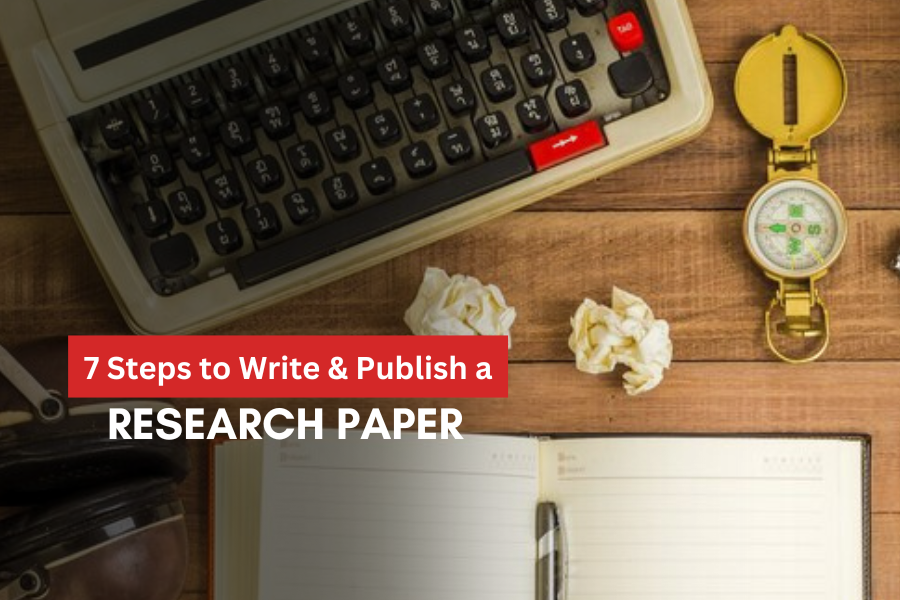7 Steps to Write & Publish a Research Paper
- aimlay01
- Feb 3
- 3 min read

Writing and publishing a research paper can seem overwhelming, but breaking it down into manageable steps can make the process smoother and more efficient. Below are seven essential steps to help you write and publish your research paper successfully.
1. Choose a Research Topic
The first and most crucial step is selecting a research topic that is relevant, interesting, and feasible. Consider the following factors while choosing your topic:
Interest & Passion: Choose a subject that excites you.
Relevance: Ensure the topic is significant in your field.
Feasibility: Consider the availability of data and resources.
Novelty: Aim for a fresh perspective or new findings.
Once you finalize a topic, conduct a preliminary literature review to identify gaps in existing research and refine your research question.
2. Conduct a Thorough Literature Review
A comprehensive literature review helps you understand the background of your research and positions your study within the existing body of knowledge. To conduct an effective literature review:
Use Reliable Sources: Rely on peer-reviewed journals, books, and reputable databases such as PubMed, Google Scholar, or IEEE Xplore.
Identify Key Papers: Recognize landmark studies in your field.
Analyze Trends: Observe how the topic has evolved over time.
Find Research Gaps: Identify areas that need further exploration.
Organize the reviewed literature thematically and cite sources properly to avoid plagiarism.
3. Develop a Research Plan & Methodology
The research methodology defines how you will conduct your study. Your approach depends on the type of research:
Qualitative Research: Interviews, case studies, or thematic analysis.
Quantitative Research: Experiments, surveys, statistical analysis.
Mixed-Methods Research: A combination of both qualitative and quantitative methods.
Ensure you outline the data collection process, sampling techniques, and tools you will use for analysis. If applicable, seek ethical clearance before beginning data collection.
4. Write the Research Paper
Once you have gathered sufficient data and insights, start writing your paper. A standard research paper writing consists of the following sections:
Title
Should be concise, clear, and informative.
Include keywords for better indexing.
Abstract
A summary of the entire study, including objectives, methods, key findings, and conclusions.
Usually limited to 150-250 words.
Introduction
Introduce the research problem and its significance.
Provide a brief literature review.
Clearly state the research objectives and hypothesis (if applicable).
Methodology
Explain the research design, data collection techniques, and analytical methods.
Provide enough details for replication.
Results
Present the findings objectively using tables, graphs, and statistics.
Avoid interpreting results in this section.
Discussion
Interpret results in the context of existing literature.
Discuss implications, limitations, and future research directions.
Conclusion
Summarize key findings and their significance.
Suggest practical applications or future research.
References
Cite all sources in the appropriate referencing style (APA, MLA, Chicago, etc.).
5. Edit & Proofread Your Paper
A well-written paper should be clear, concise, and free from errors. Take the following steps to refine your manuscript:
Grammar & Spelling Check: Use tools like Grammarly or professional proofreading services.
Clarity & Conciseness: Ensure ideas are presented clearly and concisely.
Technical Accuracy: Verify that data, formulas, and references are correct.
Consistency: Follow a uniform structure, tone, and citation style.
Peer Review: Ask colleagues or mentors to review your paper and provide feedback.
6. Select a Suitable Journal & Submit Your Paper
Choosing the right journal is critical for successful publication. Consider:
Scope & Audience: Ensure your research aligns with the journal’s scope.
Impact Factor: High-impact journals increase visibility.
Open Access vs. Subscription: Decide whether you prefer a wider readership (open access) or a traditional journal.
Submission Guidelines: Follow formatting and submission instructions precisely.
Prepare a cover letter and follow the journal’s submission portal to upload your manuscript.
7. Address Reviewer Comments & Publish
After submission, your paper will undergo peer review. Be prepared for:
Acceptance: If accepted, follow final publication procedures.
Minor/Major Revisions: Address reviewer comments meticulously and resubmit.
Rejection: If rejected, revise and submit to another journal.
Respond to reviewers professionally, making necessary improvements and providing clarifications where required.
Conclusion
Writing and publishing a research paper is a systematic process that requires planning, dedication, and attention to detail. By following these seven steps—choosing a topic, reviewing literature, developing methodology, writing, editing, selecting a journal, and addressing feedback—you can successfully publish your research and contribute valuable knowledge to your field.








Comments